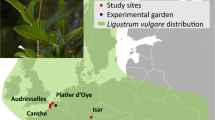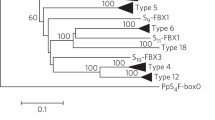Summary
The evolutionary significance of self-incompatibility (SI) traditionally has been linked to reduced inbreeding through enforced outcrossing. This view is founded on the premise that outcrossing reduces inbreeding. It is important, when considering the evolutionary significance of any genetic system, to try to distinguish those factors related to the evolution of, from those related to the maintenance of, the system in question. Three factors are considered important for the maintenance of SI: (1) phylogenetic constraint in species descended from SI ancestors, (2) reduced inbreeding in populations, and (3) fitness benefits to individuals resulting from the avoidance of selfing. I suggest that the first two factors should be rejected when considering the origin of SI (whether one or more origins are hypothesized) and that the increase in individual fitness resulting from the avoidance of self-fertilization among individuals that are heterozygous for deleterious alleles may be sufficient to account for the origin of SI. Self-fertilization in plants (except in species that predominantly self-fertilize) generally results in a reduction in fitness of some individuals due to the increased expression of deleterious or lethal recessive alleles, regardless of the degree of inbreeding in the population or the frequency of the allele in question. Inbreeding is a consequence of population structure in many outcrossing plant species. Complex (multi-locus and multi-allelic) systems of SI exist that reduce inbreeding. However, it is argued that these are derived either from simpler systems of SI that may have very little or no effect on inbreeding, in which case any effect on level of inbreeding is secondary, or are not true self-incompatibility systems and are part of a regulatory system that serves to balance the level of inbreeding and outbreeding. Multi-locus and multi-allelic systems of SI and heteromorphic systems of SI are discussed in terms of derived versus ancestral characteristics. A reassessment of the role of breeding systems in the development of a population structure promoting inbreeding is suggested, which may have been of crucial importance in the success and diversification of angiosperms.
Similar content being viewed by others
References
Anderson M, Cornish E, Mau S, Williams E, Hoggart R, Atkinson A, Bonig I, Grego B, Simpson R, Roche R, Haley J, Penschow J, Niall H, Tregear G, Coghlan J, Crawford R, Clarke A (1986) Cloning of cDNA for a stylar glycoprotein associated with expression of self-incompatibility in Nicotiana alata. Nature 321:38–44
Ascher PD (1984) Discriminating styles and pollen-mediated pseudo-self compatibility. Am J Bot 71 (5, part 2):98
Baker H (1959) Reproductive methods as factors in speciation in flowering plants. Cold Spring Harbor Symp Quant Biol 24:177–191
Barrett S (1979) The evolutionary breakdown of tristyly in Eichornia crassipes (Mart.) Solms (water hyacinth). Evolution 33:499–510
Barrett S (1985) Ecological genetics of breakdown in tristyly. In: Haeck J, Woldendorp JW (eds) Structure and functioning of plant populations, vol 2. North Holland, Amsterdam New York, pp 267–275
Barrett S (1988) The evolution, maintenance, and loss of self-incompatibility systems. In: Lovett-Doust J, Lovett-Doust L (eds) Plant reproductive ecology. Oxford University Press, New York, pp 98–124
Bateman AJ (1952) Self-incompatibility systems in angiosperms. I. Theory. Heredity 6:285–310
Bawa K (1980) Evolution of dioecy in flowering plants. Annu Rev Ecol Syst 11:15–39
Beach J (1981) Pollinator foraging and the evolution of dioecy. Am Nat 118:572–577
Beach JH, Bawa K (1980) Role of pollination in the evolution of dioecy from distyly. Evolution 34:1138–1142
Beach JH, Kress WJ (1980) Sporophyte versus gametophyte. A note on the origin of self-incompatibility in flowering plants. Syst Bot 5:1–5
Brewbaker JL (1967) The distribution and phylogenetic significance of binucleate and trinucleate pollen grains in the angiosperms. Am J Bot 54:1069–1083
Campbell JM, Lawrence MJ (1981) The population genetics of the self-incompatibility polymorphism in Papaver rhoeas. II. The number and frequency of S-alleles in a natural population (R106). Heredity 46:81–90
Charlesworth D (1979) The evolution and breakdown of tristyly. Evolution 33:486–498
Charlesworth D (1985) Distribution of dioecy and self-incompatibility in angiosperms. In: Greenwood J, Slatkin M (eds) Evolution — essays in honour of John Maynard Smith. Cambridge University Press, Cambridge, pp 237–268
Charlesworth D, Charlesworth B (1979a) The evolutionary genetics of sexual systems in flowering plants. Proc R Soc London Ser B 205:513–530
Charlesworth D, Charlesworth B (1979b) The evolution and breakdown of S-allele systems. Heredity 43:41–55
Crepet WL (1983) The role of insect pollination in the evolution of the angiosperms. In: Real L (ed) Pollination biology. Academic Press, Orlando, Fla, pp 29–50
Crepet WL (1984) Advanced (constant) insect pollination mechanisms: patterns of evolution and implications vis-avis angiosperm diversity. Ann Mo Bot Gard 71:607–630
Crow JF, Kimura M (1970) An introduction to population genetics theory. Harper & Row, New York
Crowe LK (1964) The evolution of outbreeding in plants. I. The angiosperms. Heredity 19:435–457
Cruden RW (1988) Temporal dioecism: systematic breadth, associated traits, and temporal patterns. Bot Gaz (Chicago) 149:1–15
Darwin C (1876) The effects of cross- and self-fertilization in the vegetable kingdom. Murray, London
Doyle JA, Hickey LJ (1976) Pollen and leaves from the Mid-Cretaceous Potomac Group and their bearing on early angiosperm evolution. In: Beck CB (ed) Origin and early evolution of angiosperms. Columbia University Press, New York, pp 139–206
East EM (1940) The distribution of self-sterility in the flowering plants. Proc Am Philos Soc 82:449–518
East EM, Mangelsdorf AJ (1925) A new interpretation of the hereditary behavior of self-sterile plants. Proc Natl Acad Sci USA 11:166–177
Emerson SH (1938) The genetics of self-incompatibility in Oenothera organensis. Genetics 23:190–202
Ewens WJ (1964) The distribution of self-sterility alleles. Genetics 50:1433–1438
Falconer DS (1960) Introduction to quantitative genetics. Oliver & Boyd, Edinburgh
Ganders F (1979) Evolution of heterostyly. NZ J Bot 17:607–635
Givnish T (1982) Outcrossing versus ecological constraints in the evolution of dioecy. Am Nat 119:849–865
Gottlieb LD (1982) Conservation and duplication of isozymes in plants. Science 216:373–380
Gould SJ, Vrba E (1982) Exaptation — a missing term in the science of form. Paleobiology 8:4–15
Grant V (1975) Genetics of flowering plants. Columbia University Press, New York
Heslop-Harrison J (1983) Self-incompatibility: phenomenology and physiology. Proc R Soc London Ser B 218:371–395
Holsinger K (1986) Dispersal and plant mating systems: the evolution of self-fertilization in subdivided populations. Evolution 40:405–413
Jagorski JS, Ascher PD, Widmer RE (1983) Multigenic selfincompatibility in hexaploid Chrysanthemum. Euphytica 32:1–7
Kress WJ (1983) Self-incompatibility in Central America Heliconia. Evolution 37:735–744
Lande R, Schemske D (1985) The evolution of self-fertilization and inbreeding depression in plants. I. Genetic models. Evolution 39:24–40
Larsen K (1977) Self-incompatibility in Beta vulgaris L. I. Four gametophytic, complementary S-loci in sugar beet. Hereditas 85:227–248
Larsen K (1985) Cell surface recognition glycoproteins and their possible role in angiosperm self-incompatibility. In: Willemse MTM, Went JL van (eds) Sexual reproduction in seed plants, ferns and mosses. Pudoc, Wageningen, pp 112–114
Lawrence MJ, Marshall DF, Curtis VE, Fearon CH (1985) Gametophytic self-incompatibility re-examined: a reply. Heredity 54:131–138
Levin D (1981) Dispersal vs gene flow in plants. Ann Mo Bot Gard 68:233–253
Levin D, Wilson J (1978) The genetic implications of ecological adaptations in plants. In: Freysen A, Woldendorp J (eds) Structure and functioning of plant populations. North Holland, Amsterdam New York, pp 75–100
Lewis D (1979) Genetic versatility of incompatibility in plants. NZ J Bot 17:637–644
Lewis D, Rao A (1971) Evolution of dimorphism and population polymorphism in Pemphis acidula Forst. Proc R Soc London Ser B 178:79–94
Lloyd D (1979) Some reproductive factors affecting the selection of self-fertilization in plants. Am Nat 113:67–79
Loveless M, Hamrick J (1984) Ecological determinants of genetic structure in populations. Annu Rev Ecol Syst 14:65–95
Lundqvist A (1962) The nature of the two-loci incompatibility system in grasses. I. The hypothesis of duplicative origin. Hereditas 48:169–181
Lundqvist A (1975) Complex self-incompatibility systems in angiosperms. Proc R Soc London Ser B 188:235–245
Mather K (1973) Genetical structure of populations. Chapman and Hall, London
Maynard Smith J (1978) The evolution of sex. Cambridge University Press, Cambridge
Mayr E (1963) Animal species and evolution. Harvard University Press, Cambridge
McLeod MJ, Guttman SI, Eshbaugh WH, Rayle RE (1983) An electrophoretic study of evolution in Capsicum (Solanaceae). Evolution 37:562–574
Mulcahy DL (1964) The reproductive biology of Oxalis priceae. Am J Bot 51:1045–1050
Mulcahy DL, Mulcahy GB (1983) Gametophytic self-incompatibility re-examined. Science 220:1247–1251
Muenchow G (1981) An S-locus model for the distyly supergene. Am Nat 118:756–760
Muller HJ (1950) Our load of mutations. Am J Hum Genet 2:111–176
Nagylaki T (1975) The deterministic behavior of self-incompatibility alleles. Genetics 79:545–550
Nasrallah J, Kao T, Goldberg M, Nasrallah M (1985) A cDNA clone incoding an S-locus-specific glycoprotein from Brassica oleracea. Nature 318:263–267
Nettancourt D de (1977) Incompatibility in angiosperms. Springer, Berlin Heidelberg New York
Olmstead RG (1986) Self-incompatibility in light of population structure and inbreeding. In: Mulcahy DL, Mulcahy GB, Ottaviano E (eds) Biotechnology and ecology of pollen. Springer, Berlin Heidelberg New York, pp 239–244
Opler AT, Baker H, Frankie G (1980) Plant reproductive characteristics during secondary succession in neotropical low-land forest ecosystems. Biotropica 12 [Suppl]:40–46
Parkin DT (1979) An introduction to evolutionary genetics. Arnold, London
Partridge L (1983) Non-random mating and offspring fitness. In: Bateson P (ed) Mate choice. Cambridge University Press, Cambridge, pp 227–253
Regal RJ (1977) Ecology and evolution of flowering plant dominance. Science 196:622–629
Richards AJ (1986) Plant breeding systems. Allen and Unwin, London
Ruiz Z, Arroyo T, Arroyo MTK (1978) Plant reproductive ecology of a secondary deciduous tropical forest in Venezuela. Biotropica 10:221–230
Schemske D, Lande R (1985) The evolution of self-fertilization and inbreeding depression in plants. II. Empirical observations. Evolution 39:41–52
Shields WM (1982) Philopatry, inbreeding, and the evolution of sex. State University New York Press, Albany
Shields WM (1983) Optimal inbreeding and the evolution of philopatry. In: Swingland JR, Greenwood PJ (eds) The ecology of animal movement. Clarendon Press, Oxford, pp 132–159
Sobrevila C, Arroyo MTK (1982) Breeding systems in a montane tropical cloud forest in Venezuela. Plant Syst Evol 140:19–37
Stebbins GL (1957) Self-fertilization and population variability in the higher plants. Am Nat 91:337–354
Stebbins GL (1974) Flowering plants: evolution above the species level. Harvard University Press, Cambridge
Thompson J, Barrett S (1981) Selection for outcrossing, sexual selection, and the evolution of dioecy in plants. Am Nat 118:443–449
Uyenoyama M (1988a) On the evolution of genetic incompatibility systems: incompatibility as a mechanisms for the regulation of outcrossing distance. In: Levin BR, Michod RE (eds) The evolution of sex: an examination of current ideas. Sinauer, Sunderland, Mass, pp 212–232
Uyenoyama M (1988a) On the evolution of genetic incompatibility systems. II. Initial increase of strong gametophytic self-incompatibility under partial selfing and half-sib mating. Am Nat 131:700–722
Weller S (1976) The genetic control of tristyly in Oxalis section Ionoxalis. Heredity 37:387–392
Wiens D (1984) Ovule survivorship, brood size, life history, breeding systems, and reproductive success in plants. Oecologia 64:47–53
Whitehouse HKL (1950) Multiple-allelemorph incompatibility of pollen and style in the evolution of angiosperms. Ann Bot (London) 14:198–216
Willson MF (1983) Plant reproductive ecology. Wiley, New York
Wright S (1922) Coefficients of inbreeding and relationship. Am Nat 56:330–338
Wright S (1939) The distribution of self-sterility alleles in populations. Genetics 24:538–552
Wright S (1940) Breeding structure of populations in relation to speciation. Am Nat 74:232–248
Author information
Authors and Affiliations
Rights and permissions
About this article
Cite this article
Olmstead, R.G. The origin and function of self-incompatibility in flowering plants. Sexual Plant Reprod 2, 127–136 (1989). https://doi.org/10.1007/BF00192758
Issue Date:
DOI: https://doi.org/10.1007/BF00192758




